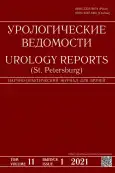Применение пантогематогена сухого для лечения пациентов с дисциркуляторными расстройствами при хроническом простатите (экспериментально-клиническое исследование)
- Авторы: Тихонов И.В.1, Титяев И.И.2, Касьянов Д.С.2, Чекушин Р.Х.3
-
Учреждения:
- ООО Санаторий-профилакторий "Станкостроитель"
- ГБУЗ НСО «Городская клиническая больница №1»
- ГБУЗ «Кузбасский клинический кожно-венерологический диспансер»
- Выпуск: Том 11, № 1 (2021)
- Страницы: 63-68
- Раздел: Оригинальные статьи
- URL: https://journal-vniispk.ru/uroved/article/view/50229
- DOI: https://doi.org/10.17816/uroved50229
- ID: 50229
Цитировать
Аннотация
Цель. Изучить в эксперименте и клинических условиях эффективность препарата пантогематоген сухой, полученного из крови марала, для коррекции дисциркуляторных расстройств в предстательной железе.
Материалы и методы. Экспериментально-морфологическая часть работы выполнена на 90 крысах-самцах Вистар с локальным венозным застоем в малом тазу вследствие лигирования внутренних подвздошных вен. Животным основной группы (n = 30) проводили энтеральную коррекцию пантогематогеном сухим (в суточной дозе 10 мг на 100 г массы животного) начиная с 7-х суток после моделирования заболевания, курс 14 сут. Крысам 2-й группы (n = 30) после моделирования венозного застоя лечение не проводили. Третью группу составили интактные животные. Во время клинического этапа исследования проводили лечение 61 больного хроническим конгестивным простатитом. Все пациенты получали стандартную терапию, а пациентам группы лечения (n = 30) дополнительно проводили высокодисперсные аэрозольные трансректальные орошения водным раствором пантогематогена, ежедневно, на курс 10 процедур.
Результаты и обсуждение. Морфологическое исследование предстательной железы лабораторных животных с экспериментальным дисциркуляторным простатитом и последующей его энтеральной коррекцией пантгематогеном сухим свидетельствовало о значимых различиях по сравнению с животными 2-й группы. Отмечена тенденция к восстановлению нормальной структуры простаты, ее метаболизма, регионарного и органного крово- и лимфооттока, улучшению дренажно-детоксикационной и транспортной активности ее регионарных лимфатических узлов. В клинической части исследования показана эффективность применения пантогематогена у больных хроническим конгестивным простатитом. По окончании курса лечения у пациентов 1-й группы наблюдали исчезновение болевого (в 72,4 % случаев) и дизурического (в 86,2 % случаев) синдромов, а у остальных — уменьшение их интенсивности. По данным трансректального ультразвукового исследования предстательной железы у пациентов 1-й группы после лечения в 52 % случаев было отмечено уменьшение объема предстательной железы.
Выводы. Результаты экспериментально-клинического исследования указывают на перспективность включения пантогематогена в комплексную терапию больных хроническим конгестивным простатитом.
Полный текст
Открыть статью на сайте журналаОб авторах
Игорь Викторович Тихонов
ООО Санаторий-профилакторий "Станкостроитель"
Email: tihonoff2701@yandex.ru
Доктор медицинских наук, заведующий медицинской службой, врач-уролог
Россия, 656045, Алтайский край, Барнаул, ул. Тихонова, д.33, корпус БИгорь Иванович Титяев
ГБУЗ НСО «Городская клиническая больница №1»
Email: den-sk@ya.ru
Доктор медицинских наук, профессор, врач-уролог отделения урологии
Россия, 630047, Новосибирск, ул. Залесского. д. 6Денис Сергеевич Касьянов
ГБУЗ НСО «Городская клиническая больница №1»
Автор, ответственный за переписку.
Email: kasyanovds@mail.ru
Врач-уролог, врач-онколог Центра амбулаторной поликлинической помощи
Россия, 630047, Новосибирск, ул. Залесского. д. 6Рамиль Хусанович Чекушин
ГБУЗ «Кузбасский клинический кожно-венерологический диспансер»
Email: kasyanovds@mail.ru
Врач-дерматовенеролог, кандидат медицинских наук
Россия, 650025, Кемерово, ул. Рукавишникова, д.41Список литературы
- Божедомов В.А. Современные возможности лечения хронического простатита // Андрология и генитальная хирургия. 2016. Т. 17, № 3. С. 10–22. doi: 10.17650/2070-9781-2016-17-3-10-22
- Молочков В.А., Ильин И.И. Хронический уретрогенный простатит. М.: Медицина, 2010. 304 с.
- Кубанова А.А., Вавилов А.М., Волнухин В.А., и др. Рациональная фармакотерапия заболеваний кожи и инфекций, передаваемых половым путем / под общей ред. А.А. Кубановой. М.: Литтерра, 2007. 512 с.
- Paulis G. Inflammatory mechanisms and oxidative stress in prostatitis: the possible role of antioxidant therapy // Res Rep Urol. 2018. Vol. 17, No. 10. P. 75–87. doi: 10.1007/978-3-319-71282-6_4
- Дендеберов Е.С., Логвинов Л.А., Виноградов И.В., и др. Тактика выбора схемы терапии бактериального простатита // Русский медицинский журнал. 2011. Т. 19, № 32. С. 2071–2074.
- Кульченко Н.Г., Яценко Е.В. Фитотерапия при воспалительных заболеваниях предстательной железы // Исследования и практика в медицине. 2019. Т. 6, № 3. С. 87–97. doi: 10.17709/2409-2231-2019-6-3-8
- Vermassen T., Van Praet C., Poelaert F., et al. Diagnostic accuracy of urinary prostate protein glycosylation profiling in prostatitis diagnosis // Biochem Med (Zagreb). 2015. Vol. 25, No. 3. P. 439–449. doi: 10.11613/BM.2015.045
- Suskind A.M., Berry S.H., Ewing B.A., et al. The prevalence and overlap of interstititial cystitis/bladder pain syndrome and chronic prostatitis/chronic pelvic pain syndrome in men: results of the RAND Interstitial Cystitis Epidemiology Male Study // J Urol. 2013. Vol. 189, No. 1. P. 141–145. doi: 10.1016/j.juro.2012.08.088
- Пушкарь Д.Ю., Раснер П.И., Котенко Д.В., и др. Особенности симптомов нижних мочевыводящих путей у мужчин Московского региона. Результаты эпидемиологического исследования // Урология. 2018. № 3. С. 20–28.
- Шпиленя Е.С. Классификация UPOINT: особенности и преимущества // Вестник Российского общества урологов. 2019. № 2. С. 10.
- Сегал А.С. Диагностика и лечение хронического простатита // Русский медицинский журнал. 2003. Т. 11. № 8. С. 453–458.
- Козлов Б.И., Попова И.С. Пантолечение. Пособие для врачей и фармацевтов. Барнаул, 2014. 44 с.
- Лазарева В.А. Применение пантогематогена в комплексном лечении больных хроническим простатитом. Методическое пособие для врачей. Новосибирск, 2007.
- Тихонов И.В. Эффективность использования биологически активной добавки к пище «Фитопан М» в комплексной санаторной реабилитации больных хроническим простатитом // Актуальные проблемы восстановительной медицины, курортологии и физиотерапии: Сборник научных трудов Всероссийского форума «Здравница». СПб, 2004 С. 245.
- Тихонов И.В. Региональные лимфатические узлы предстательной железы в норме, при венозном застое в малом тазу и в условиях физио- и фитокоррекции: автореф. дис. … д-ра мед. наук. Новосибирск, 2008. Режим доступа: http://medical-diss.com/medicina/regionarnye-limfaticheskie-uzly-prostaty-v-norme-pri-venoznom-zastoe-v-malom-tazu-i-v-usloviyah-fizio-i-fitokorrektsii Дата обращения: 08.04.21.
- Авцын А.П., Жаворонков А.А., Риш М.А., Строчкова Л.С. Микроэлементозы человека. М.: Медицина, 1991. 496 с.
- Проблемы лимфангиологии / под ред. Ю.И. Бородина, В.И. Коненкова, А.Ф. Повещенко. Новосибирск: Манускрипт, 2010. 403 с.
Дополнительные файлы









